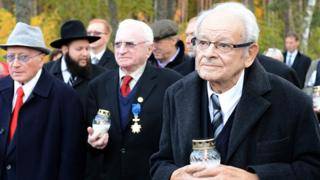Armed Jews killing Nazis is a good thing
The Treblinka Rebellion
1943

The Lenin Ghetto Assault
1942

Zdzieciol Ghetto Partisans
1942-44

10 Incredible Cases Of Jewish Resistance During The Holocaust - Listverse
Though most Western depictions of World War II focus on soldiers rescuing helpless victims from German oppression, the truth is very different. The human species doesn’t take kindly to genocide or oppression, and the Jews are no exception.
The Treblinka Rebellion
1943

.On August 2, 1943, the prisoners fought back. About half of the 1,500 inmates allowed to live in the camp invaded the camp armory after three Jews walked up to the two guards at the rear door and stabbed them with their own knives before they could sound an alarm, whereupon the Jews stole small arms from the armory and opened fire on the SS guards throughout Camp II. The prisoners seized kerosene stores and set fire to every building while the guards and watchtowers began shooting back. The Jews broke into Camp I and armed some of its inmates, and then about 600 men and women broke through the outer perimeter and ran for their lives into the woods. All but about 40 of these were recaptured within a week and executed. Those 40 survived the war
The Lenin Ghetto Assault
1942

There were a few thousand Jews in the ghetto until August 14, 1942, when the SS entered and murdered almost every single human being, including infants. Thirty people were spared to work in the ghetto as tailors and woodwrights, and they were guarded by an SS garrison of 100, plus 30 Aryan Belarusian policemen who also hated the Jews.
On 12 September 1942, the town was assaulted from the northeast by about 150 partisan soldiers, including the famous Bielski brothers, who killed thirty SS officers, soldiers, and police. They then broke through the wall, evacuated the 30 Jews remaining, and burned the ghetto to the ground before retreating into the surrounding woodland.
Zdzieciol Ghetto Partisans
1942-44

Alter Dvoretsky, a local lawyer, organized a resistance group of about 60 people, who acquired guns and ammunition, and prepared to arm the ghetto residents in the event that it would be liquidated. These Partisan rebels cooperated with the Soviet Red Army in ambushing German patrols and stealing all weapon and food supplies from two dozen supply depots.
The SS decided that this activity was a result of ghetto residents escaping: They liquidated the ghetto on April 30, 1942, and again on August 6. In the first incident, 1,200 of the most able-bodied Jews were marched out of the city and shot, then thrown into mass graves. The second incident resulted in 2,000 to 3,000 being shot, but the Partisans were able to fight on and remain hidden in the forests for the rest of the war.
10 Incredible Cases Of Jewish Resistance During The Holocaust - Listverse


